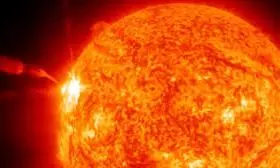
Strongest solar flare of 2025 sparks global radio blackouts, experts warn of further disruptions
text_fieldsThe most powerful solar flare of the year erupted from the sun on May 14, triggering widespread shortwave radio blackouts across multiple continents.
The flare, classified as an X2.7 event, is part of a series of solar outbursts that scientists say could continue in the days ahead.
The powerful solar eruption, recorded around 4:25 a.m. ET, released an intense burst of X-rays and ultraviolet radiation that reached Earth within minutes.
The resulting ionization of the upper atmosphere disrupted high-frequency (HF) radio communication in regions including North and South America, Southeast Asia, Africa, and the Middle East, according to reports from Space.com.
Aurora chaser Vincent Ledvina commented on social media, “This is getting intense,” as the active sunspot region responsible, known as AR4087, continued moving into a position directly facing Earth.
The U.S. National Oceanic and Atmospheric Administration’s Space Weather Prediction Center (NOAA SWPC) noted that while X-class solar flares are the most powerful of the five flare categories — A, B, C, M, and X — events of this scale are uncommon. “Flares of this magnitude are not frequent,” NOAA stated.
Just hours after the initial X2.7 flare, AR4087 erupted again, producing an M5.3-class flare later the same day. Early on May 15, it emitted yet another strong M7.74-class flare, further underscoring the sunspot’s volatility.
As AR4087 moves toward a more direct alignment with Earth, scientists are cautioning satellite operators, radio technicians, and power companies to prepare for additional solar activity that could lead to further blackouts or even disturbances to electrical grids.
The recent flare activity highlights several risks associated with heightened solar storms:
Radio blackouts: High-frequency radio signals can be temporarily lost due to sudden ionization of Earth’s upper atmosphere.
Power grid vulnerability: Induced electrical currents from solar storms can damage transformers and other critical infrastructure.
Satellite disruption: Radiation from flares and associated coronal mass ejections (CMEs) can interfere with satellite operations, including GPS navigation and communications.
With AR4087 remaining active and aligned with Earth for several more days, space weather experts are monitoring the situation closely and warn that further eruptions could occur.












